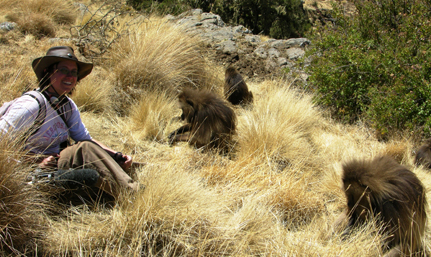Study shows that even cheating monkeys alter their behaviour to avoid detection and punishment
|
 |
Dr Le Roux sharing a moment with the geladas (Theropithecus gelada).
Photo: Supplied
11 March 2013 |
A recent article headed by Dr Aliza le Roux from the University of the Free State Qwaqwa Campus’ Department of Zoology and Entomology, asserts that cheating and deception is not only a human phenomenon - it is also found in non-human animals.
“Our specific study investigated cheating and punishment in geladas. While human beings are known to deceive one another, and punish cheaters that get caught, it is actually very rare to find proof of this kind of behaviour in non-human animals,” said Dr Le Roux.
“We don't know if this is because humans are uniquely deceitful, or if it is just that animals deal with cheating differently. Our study was therefore the first to demonstrate that gelada males and females try to deceive their partners when they are cheating on them. This means they try to hide their unfaithful behaviour.” This is therefore the first investigation to document tactical deception in primates living in a natural environment.
“We also showed that the cuckolded males then punish the cheaters, but could not determine if the punishment actually caused cheaters to stop cheating,” said Dr Le Roux.
This on-going and long-term study continues to observe the population of wild geladas in the Simien Mountains National Park in Ethiopia. The study investigates primate hormones, cognition, genetics, social behaviour and conservation, and is done in collaboration with the Universities of Michigan and Pennsylvania.
The full version of the article can be accessed on (http://www.nature.com/ncomms/journal/v4/n2/full/ncomms2468.html).